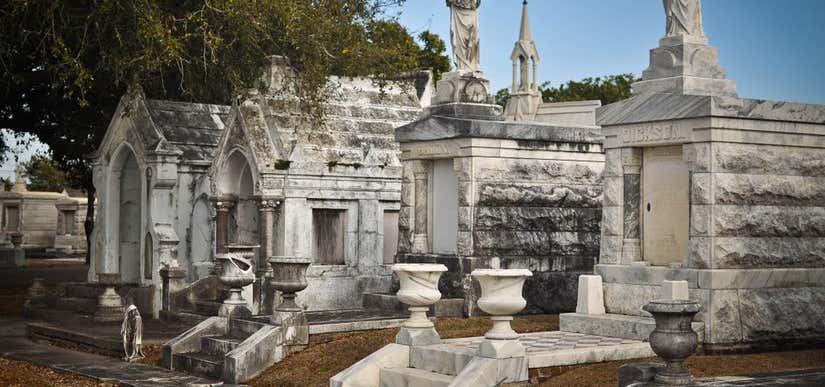“the largest collection of elaborate marble tombs & funeral statuary in the city”
Metairie Cemetery is a cemetery in New Orleans, Louisiana, United States. The name has caused some people to mistakenly presume that the cemetery is located in Metairie, Louisiana, but it is located within the New Orleans city limits, on Metairie Road (and formerly on the banks of the since filled in Bayou Metairie). This site was previously a horse racing track, Metairie Race Course, founded in 1838. The race track was the site of the famous Lexington-Lecomte Race, April 1, 1854, billed as the "North against the South" race. Former President Millard Filmore attended. While racing was suspended because of the American Civil War, it was used as a Confederate Camp (Camp Moore) until David Farragut took New Orleans for the Union in April 1862. Metairie Cemetery was built upon the grounds of the old Metairie Race Course after it went bankrupt. The race track, which was owned by the Metairie Jockey Club, refused membership to Charles T. Howard, a local resident who had gained his wealth by starting the first Louisiana State Lottery. After being refused membership, Howard vowed that the race course would become a cemetery. Sure enough, after the Civil War and Reconstruction, the track went bankrupt and Howard was able to see his curse come true. Today, Howard is buried in his tomb located on Central Avenue in the cemetery, which was built following the original oval layout of the track itself. Mr. Howard died in 1885 in Dobbs Ferry, New York when he fell from a newly purchased horse. Metairie Cemetery is owned and operated by Stewart Enterprises, Inc., of Jefferson, Louisiana. Metairie Cemetery has the largest collection of elaborate marble tombs and funeral statuary in the city. One of the most famous is the Army of Tennessee, Louisiana Division monument, a monumental tomb of Confederate soldiers of the American Civil War. The monument includes two notable works by sculptor Alexander Doyle (1857–1922): Atop the tomb is a 1877 equestrian statue of General Albert Sidney Johnston on his horse "Fire-eater", holding binoculars in his right hand. General Johnston was for a time entombed here, but the remains were later removed to Texas. To the right of the entrance to the tomb is a 1885 life size statue represents a Confederate officer about to read the roll of the dead during the American Civil War. The statue is said to be modeled after Sergeant William Brunet of the Louisiana Guard Battery, but is intended to represent all Confederate soldiers. Other notable monuments in Metairie Cemetery include: the pseudo-Egyptian pyramid the former tomb of Storyville madam Josie Arlington. A temporary special spur railroad line was built to bring the materials for this monument. Memorial of 19th-century police chief David Hennessy, whose murder sparked a riot.
Reviews
Beyond beautifulplace to go! I was over the moon about this place!
A nice place to walk around with the kids, away from the Bourbon Street hustle and tourist snazz. Cultural, significant, and interesting, take the kids and a picnic to the Metairie Cemetery--just take note how you got in so you can get back out. It's a big place. If you get lost, use the aerial map of your GPS to look for the exit gates near the funeral home to the north.
A cool cemetery full of intricate marble tombs. A great stop if you have time.
Be the first to add a review to the Metairie Cemetery.
/-90.1158448,29.9839285,14/300x172@2x?access_token=pk.eyJ1Ijoicm9hZHRyaXBwZXJzIiwiYSI6ImNsdjQ5N2VtZDA2bW8ycW13ZHAxeGhjbjkifQ.UIccpoAxc7g3BAuK4s9vjg)
Metairie Cemetery
Hours
- Sun - Sat: 8:00 am - 5:00 pm
Problem with this listing? Let us know.
Has RV parking changed? Let us know.
-
Parking
-
Pets Allowed
-
Restrooms
-
Wifi
-
Wheelchair Accessible
-
Credit Cards Accepted
-
Outdoor Seating
Parking, Dining
Nearby Hotels
Related Trip Guides
The top things to do on an I-10 road trip
- 55 Places
- 56:13
- 3,026 mi
Road Trip Down the Blues Highway, U.S. Route 61
- 17 Places
- 14:50
- 826 mi
A road trip along the Great River Road
- 35 Places
- 37:29
- 1,907 mi
US 80 - Dixie Overland Highway
- 61 Places
- 42:43
- 2,450 mi



